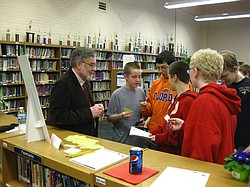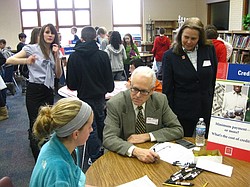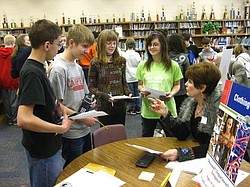CVMS students learn financial lessons
Neighbors | Submitted.Canfield Village Middle School seventh graders visited the chance booth during the real life simulation element of Real Money, Real World March 4. The one booth involved no decision-making and randomly dealt the students something unexpected..
Neighbors | Submitted.Jim Ditch (center) of Home Savings and Loan helped a Canfield Village Middle School seventh grader with a credit decision, while 4-H educator, Mahoning County OSU, Janice Hanna (left) looked on..
Neighbors | Submitted.Barbara Stacy (right) helped seventh-grade students at Canfield Village Middle School make clothing decisions during the real life simulation element of Real Money, Real World, a program that gives the students the opportunity to make lifestyle and budget choices similar to those they will face as adults.
By ABBY SLANKER
Armed with calculators and worksheets, seventh-grade students at Canfield Village Middle School jumped right into the real life simulation element of “Real Money, Real World,” a program that gives the students the opportunity to make lifestyle and budget choices similar to those they will face as adults.
The financial literacy program is a partnership between the school, the Mahoning County Ohio State University Extension and the business community and consists of three parts, including pre-simulation preparation, hands-on budget management and decision-making simulation and post-session evaluation of choices made.
Roseanne Volpini, Canfield Village Middle school home economics teacher, Janice Hanna, 4-H educator, Mahoning County OSU extension, and members of the business community who are experts in their fields all helped with the simulation program.
Students were randomly assigned occupations and a monthly salary for that occupation and were given a checkbook register. After subtracting taxes, health insurance and savings amounts, the net salary figure is deposited into the checking account and recorded in the check register. Students are also randomly assigned a number of children.
The students then went through the simulation program and had to visit each booth and purchase something from each booth.
“This program is so authentic. Look at the energy in this room. The students are really into it and are learning so much,” said Volpini.
A few students echoed Volpini’s enthusiasm for the program.
“This program is educational and fun. And it helps you be aware in life,” said seventh-grader Lizzie Matthews.
Members of the business community set up booths, which included housing, transportation, insurance, utilities, food, clothing, entertainment, child care, communications, contributions, credit and financial advice.
Volunteers manning the booths included Chuckie Eddy and Shannon Sears from Bob and Chuck Eddy Chrysler, Dodge, Jeep helping with transportation decisions, Roseanne Peluso helping with child care decisions, Reckard Insurance State Farm helping with insurance decisions, Stephanie Rasselli helping with utilities decisions, Kathy Hunsicker from Nemenz IGA helping with food decisions, Barbara Stacy, retired family consumer sciences teacher at Poland High School helping with clothing decisions, Roger Cooley helping with entertainment decisions, Sieglinde Warren helping with contributions decisions, Jim Ditch of Home Savings and Loan helping with credit decisions and Ryan Pastore with PNC Bank helping with financial advice.
The business experts gave the students information and advice and helped them make their spending decisions. The students had to make sure they made the right decisions to have money at the end of the month, and if they did not, they had to visit the financial advice booth for help on refiguring their purchases.
Canfield Village Middle School teacher Dave Izzo was waiting for the students at the finish line booth. As an added touch, Izzo handed out Payday candy bars to those students who had a positive balance and Zero candy bars to those who came out with a negative balance.
„ÄÄThe students are in Volpini’s family and consumer science class and Hanna visited their classroom one day a week for six weeks. The first four weeks were to familiarize the students with the program, the fifth week was the simulation and the sixth week she returns for an evaluation of the program from the students to ask what they learned and what surprised them the most.
“The questions I get from the students during the evaluation are so meaningful and insightful. They really enjoy the hands-on aspect of the program,” said Hanna.
“It is wonderful for our business experts to be able to come in to help the students. Everyone is busy these days, but these people took time out of their schedules to help the students,” said Hanna.
The one booth which involved no decision-making was the chance booth, which randomly dealt the students something unexpected. It could have been good, like winning free groceries or an inheritance, or bad, such as receiving a speeding ticket or having to buy four new tires for a car.
“The program is fun and helpful,” said seventh-grader Cessalee Liberato.
“You get to meet new people in the community,” said seventh-grader Renee Santisi.
 43
43



